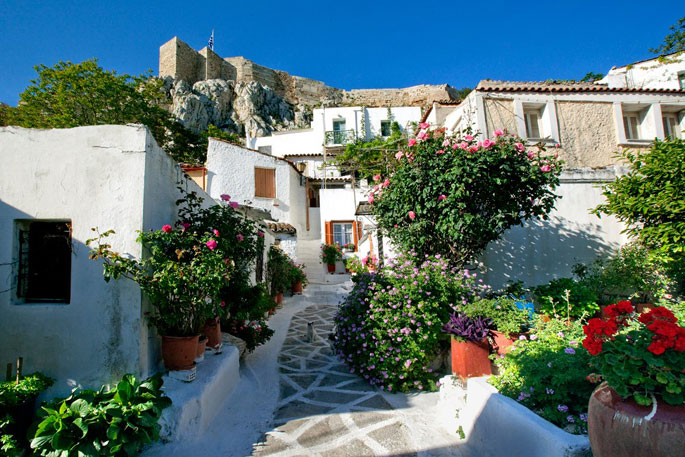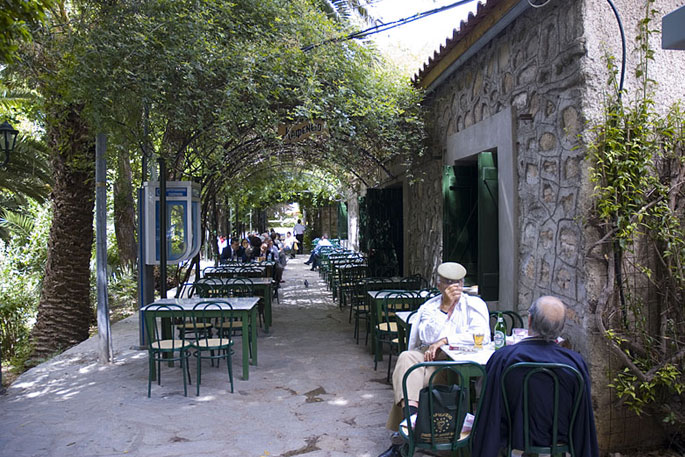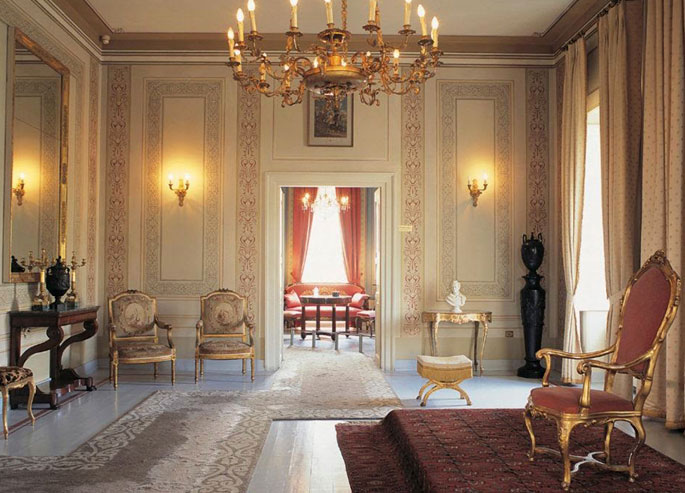The imposing building of the National Library is the easternmost of the three-building complex known as the Athenian Trilogy. Built in the 19th century to house the National Library, the University of Athens, and the Academy, the Library was designed by the famous architect, Theophil von Hansen, and financed by the Vallianos family, Greek businessmen of the diaspora. Constructed with white Pentelic marble, and enhanced by Doric columns, the building also boasts a stunning, renaissance-style, twin staircase.
The facade and vestibule are decorated with statues of the Vallianos family. It is worth noting that the National Library of Greece was originally established by Governor Ioannis Kapodistrias on the island of Aegina in 1829. At the time, the library’s vast collections were housed in numerous buildings, one of which was the small chapel of Agios Elefterios next the Cathedral. Subsequently, even more library materials were housed in the University of Athens, the two collections finally being merged in 1866, and moved permanently to its current location in 1902.
Source: www.athensattica.gr
This imposing, archaic building was built from 1859 until 1885, and was sponsored by the family of business entrepreneur, Baron Simon Sinas, who then lived in Vienna. Based on plans by Danish architect, Theophile Hanssen, and supervised by Ernst Ziller, the precise location of the construction site had already been selected in 1842, specifically chosen to be part of the famous “Athenian trilogy” of neo-classical buildings.
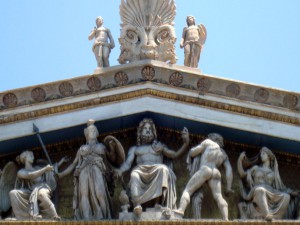 Based on Ionian era designs, the building is covered in white Pentelic marble, and its pediments adorned with Peiraic stone; statues of Athena, goddess of Letters, and Apollo, god of the Arts, both created by Leonidas Drossis, are seen standing on two high Ionic order columns overlooking the entrance. Two other impressive statues greet visitors at the entrance escalade, Plato and Aristotle. Though originally drawn by Drossis, these two statues were not completed until after his death. And although the building was ready for occupancy in 1885, the Academy was not officially founded until 1926, when it commenced operations as the supreme research establishment in the country.
Based on Ionian era designs, the building is covered in white Pentelic marble, and its pediments adorned with Peiraic stone; statues of Athena, goddess of Letters, and Apollo, god of the Arts, both created by Leonidas Drossis, are seen standing on two high Ionic order columns overlooking the entrance. Two other impressive statues greet visitors at the entrance escalade, Plato and Aristotle. Though originally drawn by Drossis, these two statues were not completed until after his death. And although the building was ready for occupancy in 1885, the Academy was not officially founded until 1926, when it commenced operations as the supreme research establishment in the country.
Source: www.athensattica.gr
 The Byzantine and Christian Museum on Vasilissis Sofias street is one of the most important Byzantine and post-Byzantine era museums in the world, with more than 25.000 objects dating from the 2nd century A.C. to the present. Containing exhibits acquired not only from Greece, but from Asia Minor and the Balkans as well, the museum, housed in the Villa Ilissia, is a magnificent example of 19th century architecture, dating from the earliest years of Greece’s liberation.
The Byzantine and Christian Museum on Vasilissis Sofias street is one of the most important Byzantine and post-Byzantine era museums in the world, with more than 25.000 objects dating from the 2nd century A.C. to the present. Containing exhibits acquired not only from Greece, but from Asia Minor and the Balkans as well, the museum, housed in the Villa Ilissia, is a magnificent example of 19th century architecture, dating from the earliest years of Greece’s liberation.
Designed by renowned Greek architect, Stamatios Kleanthis, the complex was originally built for the Duchess of Placentia, who had lived in Athens for many years. The main structure, a two-story building with a basement, was the Duchess’ primary residence. After her death, ownership of the property was transferred to the state, along with the other buildings in the complex. In 1926 the complex was assigned to house the Byzantine and Christian Museum and, after necessary alterations, opened its doors.
Museum web site:www.byzantinemuseum.gr
Source: www.athensattica.gr
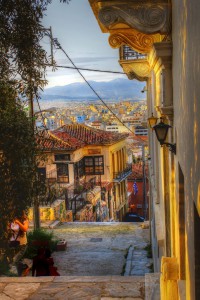 Τhe Anafiotika, one of the oldest neighbourhoods in Athens, was built on the northern slope of the Acropolis by workers and craftsmen from the Cyclades, mostly Anafi. They had flocked to the capital of the new, independent state of Greece, to work at the myriad construction projects underway at the time and, ideally, the massive project at King Otto’s Palace. Local traditions mention Damigos and Sigalas from Anafi as being this neighbourhood’s first inhabitants, followed soon by many more.
Τhe Anafiotika, one of the oldest neighbourhoods in Athens, was built on the northern slope of the Acropolis by workers and craftsmen from the Cyclades, mostly Anafi. They had flocked to the capital of the new, independent state of Greece, to work at the myriad construction projects underway at the time and, ideally, the massive project at King Otto’s Palace. Local traditions mention Damigos and Sigalas from Anafi as being this neighbourhood’s first inhabitants, followed soon by many more.
Tolerated by the authorities, these newcomers started building their homes as they always had in the Cyclades, with their flat roofs connected, and creating a labyrinth of narrow uphill streets, with little stairways carved out of the rock. The whole neighbourhood took on the appearance of a Cycladic installation.
 From 1862 until 1922 the new neighbourhood was inhabited almost solely by islanders from the Cyclades, but then refugees from Asia Minor arrived, making this their new home as well. The inhabitants then began refurbishing and repairing even the smallest, most derelict churches in the area; Ag. Georgios of the Rock, and Ag. Symeon, even adding new belfries. In the 1950’s, part of the neighbourhood was demolished to make room for archaeological excavations. Today only a few houses remain, declared as listed buildings by the state.
From 1862 until 1922 the new neighbourhood was inhabited almost solely by islanders from the Cyclades, but then refugees from Asia Minor arrived, making this their new home as well. The inhabitants then began refurbishing and repairing even the smallest, most derelict churches in the area; Ag. Georgios of the Rock, and Ag. Symeon, even adding new belfries. In the 1950’s, part of the neighbourhood was demolished to make room for archaeological excavations. Today only a few houses remain, declared as listed buildings by the state.
Source: www.athensattica.gr
 This imposing, minimalist building once served as the Royal Palace until 1909, when it was damaged by a fire. Now home to the Hellenic Parliament, the building was erected between 1836 and 1843 for King Otto. Built by Bavarian architect Gurtner, on the outskirts of the city, among the hills of the Acropolis and Lycabettus near the Mesogitiki Gate (Boubounistra). During the years prior to its final completion, the building frequently served as a luxurious, but temporary residence to wealthy and influential Athenians; that is, until the summer of 1843 when the Royal Couple finally moved in.
This imposing, minimalist building once served as the Royal Palace until 1909, when it was damaged by a fire. Now home to the Hellenic Parliament, the building was erected between 1836 and 1843 for King Otto. Built by Bavarian architect Gurtner, on the outskirts of the city, among the hills of the Acropolis and Lycabettus near the Mesogitiki Gate (Boubounistra). During the years prior to its final completion, the building frequently served as a luxurious, but temporary residence to wealthy and influential Athenians; that is, until the summer of 1843 when the Royal Couple finally moved in.
 Following the destructive fires of 1884 and 1909, the Royal Family moved to the Tatoi Palace. Over the next few years, the former palace was put to various uses, until the government of Εl. Venizelos decided to house the Parliament and Senate in the building. Extensive restoration work was performed in order to meet the needs of the legislative bodies, and finally, in 1935, the building was officially signed over to the Parliament. After the Dictatorship of Metaxas, the facility housed various state services, and the Parliament eventually resumed its operations from 1946 until today. Parliament was, however, briefly interrupted during the years of the Junta rule, from 1967 to 1974.
Following the destructive fires of 1884 and 1909, the Royal Family moved to the Tatoi Palace. Over the next few years, the former palace was put to various uses, until the government of Εl. Venizelos decided to house the Parliament and Senate in the building. Extensive restoration work was performed in order to meet the needs of the legislative bodies, and finally, in 1935, the building was officially signed over to the Parliament. After the Dictatorship of Metaxas, the facility housed various state services, and the Parliament eventually resumed its operations from 1946 until today. Parliament was, however, briefly interrupted during the years of the Junta rule, from 1967 to 1974.
Source: www.athensattica.gr
Syntagma Square is the central city square of Athens, located directly opposite the Parliament Building, formerly known as the old Royal Palace. The original name given to it during the planning of Athens was the “Square of the Muses.” However, after the Palace was erected, it was renamed, the Palace Square. But on September 3rd, 1843, following a boisterous public rally demanding that a constitution be established, it was again renamed, this time, Syntagma (Constitution) Square. The square is bordered by Amalias street, which runs directly in front of the Parliament building and the Monument of the Unknown Soldier, Vassileos Georgiou I street to the north, Philellinon street on the west, and Othonos street to the south. Beneath the square is the Syntagma Metro station.
It is worth mentioning that the numbering of the streets in Athens starts from Syntagma, and all distances to the major cities of Greece are measured from Syntagma, as well. Due to its extremely close proximity to the original Palace and current Parliament building, the square has been at the center of many major political and social events, such as the 3rd of September revolution, the raucous rallies on the day of Greece’s liberation from the Germans on October 12, 1944, the civil war events of December, 1944 and, naturally, most political speeches given by party leaders during election times.
Source: www.athensattica.gr
 The National Garden is a luscious parkland located in the heart of Athens, next to the Parliament Building, and very close to Syntagma square, with entrances from Amalias avenue, the Zappeion, Irodou Attikou street, and Vasilissis Sofias street. Founded by Queen Amalia in 1836, the ”Royal Palace Gardens” were initially planted by Bavarian horticultural specialists. Known today as the National Gardens, this spacious park is a thriving botanical paradise, containing an impressive array of local fauna.
The National Garden is a luscious parkland located in the heart of Athens, next to the Parliament Building, and very close to Syntagma square, with entrances from Amalias avenue, the Zappeion, Irodou Attikou street, and Vasilissis Sofias street. Founded by Queen Amalia in 1836, the ”Royal Palace Gardens” were initially planted by Bavarian horticultural specialists. Known today as the National Gardens, this spacious park is a thriving botanical paradise, containing an impressive array of local fauna.
Whether strolling leisurely along its paths, or simply meditating in one of the little coves, nestled amongst the remnants of ancient buildings, the experience is uniquely peaceful — even pleasantly ironic, considering that you are literally surrounded by a bustling metropolis. Augmenting the experience are the exquisite sculptures and busts of important Greeks, all accompanied by the songs of the thousands of birds who live here. In the past, the Gardens also included a small but interesting Zoo, with animals mostly native to Greece. Today it includes a small coffee shop (exit to Irodou Attikou street.), a children’s library and a playground.
Source: www.athensattica.gr
 Founded in 1839, The University of Athens was built from the designs of Christian Hanssen, the brilliant architect, who desired to construct buildings that would not only adhere to the principles of Neo-classicism, but would also complement the contemporary architecture of the city. Completed in 1864, the building had been blessed by the participation of many other fine architects, including Kaftantzoglou and Theophilas.
Founded in 1839, The University of Athens was built from the designs of Christian Hanssen, the brilliant architect, who desired to construct buildings that would not only adhere to the principles of Neo-classicism, but would also complement the contemporary architecture of the city. Completed in 1864, the building had been blessed by the participation of many other fine architects, including Kaftantzoglou and Theophilas.
 And the funding required for such a massive project was supplied by multitudes of proud Greeks from the diaspora. The murals on the facade frieze were designed by the Bavarian Rahl, but painted by Polish artist Lebientzki, after Rahl’s death. The building’s facade is decorated with the busts of Rigas Feraios, the Patriarch Gregorios V, Adamantions Korais, Gladstone, and Ioannis Kapodistrias. When the Library and the Academy were finally completed, flanking both sides of the first structure, the “Athens Trilogy” of Neo-classicism had been born.
And the funding required for such a massive project was supplied by multitudes of proud Greeks from the diaspora. The murals on the facade frieze were designed by the Bavarian Rahl, but painted by Polish artist Lebientzki, after Rahl’s death. The building’s facade is decorated with the busts of Rigas Feraios, the Patriarch Gregorios V, Adamantions Korais, Gladstone, and Ioannis Kapodistrias. When the Library and the Academy were finally completed, flanking both sides of the first structure, the “Athens Trilogy” of Neo-classicism had been born.
Source: www.athensattica.gr
Comprised of the Dekozi-Vouros Residence and the Ephtaxias Residence, this twin building complex on Paparrigopoulou street, in Klafthmonos square, houses the Museum of the City of Athens. Built in 1834 from designs by German architects Lunder and Hoffer, its construction had been commissioned by Dekozi-Vouros, a banker from Chios. Being one of the first new buildings constructed in the city, it remains a superb example of the architectural style known as early classicism. When completed, the building overlooked the still-unrepaired square, where the remnants of the heavily damaged, Hasseki wall, were visible.
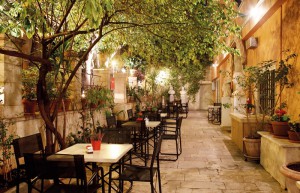 This building was home to King Otto and Queen Amalia from 1837 until 1843, when they moved to their newly built Palace. After World War II, the entire structure was restored, along with the connecting Ephtaxias Residence. All reconstruction was based on a study by distinguished architect, Ioannis Travlos. Today it houses the Museum of the City of Athens, showcasing the history of the city, from its declaration as the country’s capital, until today.
This building was home to King Otto and Queen Amalia from 1837 until 1843, when they moved to their newly built Palace. After World War II, the entire structure was restored, along with the connecting Ephtaxias Residence. All reconstruction was based on a study by distinguished architect, Ioannis Travlos. Today it houses the Museum of the City of Athens, showcasing the history of the city, from its declaration as the country’s capital, until today.
Source: www.athensattica.gr
 Known as the “Tzistarakis Mosque,” this is one of the few Muslim monuments remaining in Athens. Built in 1759 by the Governor, Tzistarakis, during the second period (1689-1821) of the Ottoman occupation, it has been rumoured that the lime used for its construction was procured by melting down a column from the Olympieion. But research has proved that a column from Hadrian’s Library was actually used. In the 20th Century, the mosque housed the Museum of Hellenic Folk Art.
Known as the “Tzistarakis Mosque,” this is one of the few Muslim monuments remaining in Athens. Built in 1759 by the Governor, Tzistarakis, during the second period (1689-1821) of the Ottoman occupation, it has been rumoured that the lime used for its construction was procured by melting down a column from the Olympieion. But research has proved that a column from Hadrian’s Library was actually used. In the 20th Century, the mosque housed the Museum of Hellenic Folk Art.
Today it serves as an annex of this museum. It is remarkable that in 1966, the mosque was partially restored so that Ibn Saud, exiled, ex-monarch of Saudi Arabia, could perform his religious duties here.
Source: www.athensattica.gr












